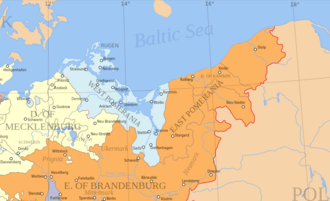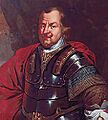Treaty of Bärwalde facts for kids
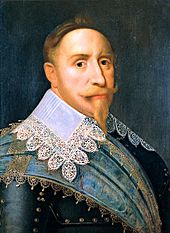
|
|
| Signed | 23 January 1631 |
|---|---|
| Location | Bärwalde, now Mieszkowice, Poland |
| Original signatories |
|
| Parties | |
| Languages | German |
The Treaty of Bärwalde was an important agreement signed on January 23, 1631. It was made between France and Sweden during the Thirty Years' War.
This treaty meant that France would give money to Sweden. Sweden had just joined the war to fight against the powerful Habsburg family in Austria.
This plan fit with what Cardinal Richelieu, France's chief minister, wanted. He wanted to weaken the Habsburgs without France getting directly involved in the fighting.
Under the treaty, Gustavus Adolphus, the Swedish king, agreed to keep an army of 36,000 soldiers. In return, France would pay Sweden 400,000 Reichsthalers each year for five years.
France kept supporting Sweden even after Gustavus Adolphus died in November 1632. But after Sweden lost a big battle at Nördlingen in September 1634, many of their German allies made peace.
Because of this, Cardinal Richelieu decided France needed to join the war directly. In 1635, a new agreement, the Franco-Swedish Treaty of Compiègne, took the place of the Treaty of Bärwalde.
Contents
Why the Treaty Was Needed
The Thirty Years War started in 1618. It began when Frederick V of the Palatinate, a Protestant ruler, became king of Bohemia. Many Germans did not get involved at first. They saw it as a family problem within the Holy Roman Empire.
Emperor Ferdinand quickly stopped the Bohemian uprising. But then, Imperial forces attacked Frederick's home, the Palatinate, forcing him to leave.
This changed the war. It worried other German princes because their own lands might be taken too. Their worry grew when Emperor Ferdinand made the 1629 Edict of Restitution. This rule said that all church lands taken since 1552 had to be given back. This usually meant from Protestants to the Catholic Church. It basically undid the 1555 Peace of Augsburg.
Also, Ferdinand paid his army by letting them take things from the lands they marched through. This included lands belonging to his allies.
These actions made Protestants in the Empire fight back more. It also brought in other countries. They were worried about the Catholic Church gaining too much power. In 1625, Christian IV of Denmark joined the fight. He had some success but had to leave in 1629.
This led to Gustavus Adolphus of Sweden getting involved. He wanted to help other Protestants. He also wanted to control the Baltic Sea trade. This trade brought a lot of money to Sweden.

In June 1630, about 18,000 Swedish soldiers landed in Duchy of Pomerania. This area had been controlled by Wallenstein since 1627. Gustavus signed an alliance with Bogislaw XIV, Duke of Pomerania. This helped him protect Sweden's interests in Pomerania. It also helped against the Catholic Polish–Lithuanian Commonwealth, which was another rival in the Baltic Sea.
Gustavus hoped for more support, but it did not happen. By the end of 1630, his only new ally was the town of Magdeburg. This town was being attacked by the Catholic League.
Even though Imperial soldiers caused a lot of damage, Saxony and Brandenburg-Prussia did not want to help Sweden. Both had their own plans for Pomerania, which did not match Gustavus's. They also knew that inviting outside powers into the Empire was easy, but getting them to leave was hard.
The Swedes pushed out the Imperial forces. But this just meant one group of people taking things was replaced by another. Gustavus could not pay or feed his large army. His soldiers became angry and did not follow rules well.
In January 1631, John George of Saxony held a meeting of German Protestant states. He hoped to create a peace agreement. Gustavus reacted by moving his army through Brandenburg to Bärwalde, by the Oder River. He set up camp there. This protected his army before he moved to Magdeburg. It also sent a clear message to those meeting in Leipzig.
How the Treaty Was Agreed
For many years in the 1500s and 1600s, Europe was shaped by the fight between France and the Habsburg family. The Habsburgs ruled Spain and the Holy Roman Empire.
In the 1620s, France had its own problems with new religious wars. So, Cardinal Richelieu, who was France's chief minister from 1624 to 1642, avoided fighting the Habsburgs directly. Instead, he gave money to their enemies. These included the Dutch, the Ottomans, and Denmark during the Thirty Years' War.
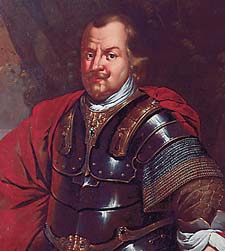
From 1628 to 1630, France fought a war with Spain over Mantua in Northern Italy. Richelieu hoped Sweden could keep Spanish forces busy in Germany. In 1629, he sent Hercule de Charnacé to the Baltic region. His job was to make a deal with Gustavus.
The talks were slow. De Charnacé quickly realized that the Swedish king was very strong and hard to control. He advised caution. A big problem was Gustavus's demand that Frederick V of the Palatinate be made ruler of the Palatinate again. But another French ally, Maximilian of Bavaria, controlled the Palatinate.
In October 1630, the Treaty of Ratisbonne ended the Mantuan War. France got what it wanted. But in return, French negotiators promised not to make alliances with parts of the Holy Roman Empire without Ferdinand's approval. This would ruin France's foreign policy. So, Louis XIII refused to sign the deal. This led to a power struggle between Richelieu and the Queen Mother, Marie de Medici. For a short time, many thought Richelieu had been fired. This event is known as the Day of the Dupes.
Richelieu won against his enemies at home. After this, Sweden's help became even more important. Sweden was an outside player, so it was not limited by the Ratisbonne treaty. De Charnacé was told to agree to a treaty as soon as possible. After talks with Swedish diplomats Gustav Horn and Johan Banér, the treaty was signed at Bärwalde on January 23, 1631.
What the Treaty Said
The treaty's main goals were to protect the Baltic Sea and ensure free trade. This included France's trading rights in the Øresund strait.
Sweden agreed to keep an army of 36,000 soldiers in Germany. Six thousand of these would be cavalry (soldiers on horseback). To help pay for this army, France agreed to pay 400,000 Reichstalers, or one million livres, each year. They also paid an extra 120,000 Reichstalers for the year 1630.
These payments were less than 2% of France's total money. But they were more than 25% of Sweden's money.
Gustavus promised to follow Imperial laws about religion. He also agreed to allow Catholics to worship freely. He would also respect the neutrality of Bavaria and the lands of the Catholic League. Both sides agreed not to make a separate peace. The treaty was set to last for five years.
What Happened After
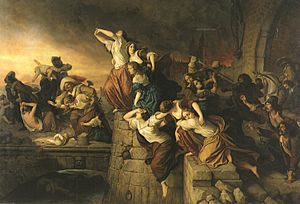
The treaty was made quickly, and it had some weaknesses that soon became clear. In May 1631, an army from the Catholic League, led by the Bavarian Count Tilly, attacked the Protestant town of Magdeburg. More than 20,000 people were said to have died. This was one of the worst events of the war. It made the conflict much more bitter and led other Protestant states to join the fight.
Gustavus then won many amazing military victories. The revenge taken by Protestants for Magdeburg became a problem for Richelieu. He was a Cardinal in the Catholic Church.
In May 1631, France and Bavaria signed the Treaty of Fontainebleau. In this treaty, Richelieu agreed to help Maximilian with soldiers if he was attacked. In theory, this did not go against the Bärwalde treaty. Gustavus had promised to respect Bavaria's neutrality. But Richelieu pointed out to Maximilian that Tilly's presence at Magdeburg broke that neutrality.
The Bärwalde treaty was not written very clearly. This gave Gustavus a lot of freedom. The events at Magdeburg also brought him support from the Dutch and England. This made him less dependent on France.
Gustavus's success ended when he died at Lützen in November 1632. Sweden kept fighting with France's help. But they lost badly at Nördlingen in September 1634. This forced the Swedish army to pull back for a while. Most of their German allies made peace with Emperor Ferdinand in the 1635 Treaty of Prague.
There were also rumors that Austria and Spain planned to attack the Spanish Netherlands. Because of all this, Louis XIII and Richelieu decided to join the war directly. In early 1635, they declared war on Spain. This started the Franco-Spanish War, which lasted until 1659.
They also made the Treaty of Compiègne with Sweden. This was an alliance against Emperor Ferdinand. This alliance lasted until the Peace of Westphalia in 1648. The Peace of Westphalia confirmed that Sweden would get Pomerania. The exact details were unclear and were only finalized by the Treaty of Stettin (1653). Sweden kept this land until 1815, except for some small changes that favored Brandenburg.
Images for kids
See also
 In Spanish: Tratado de Bärwalde para niños
In Spanish: Tratado de Bärwalde para niños


